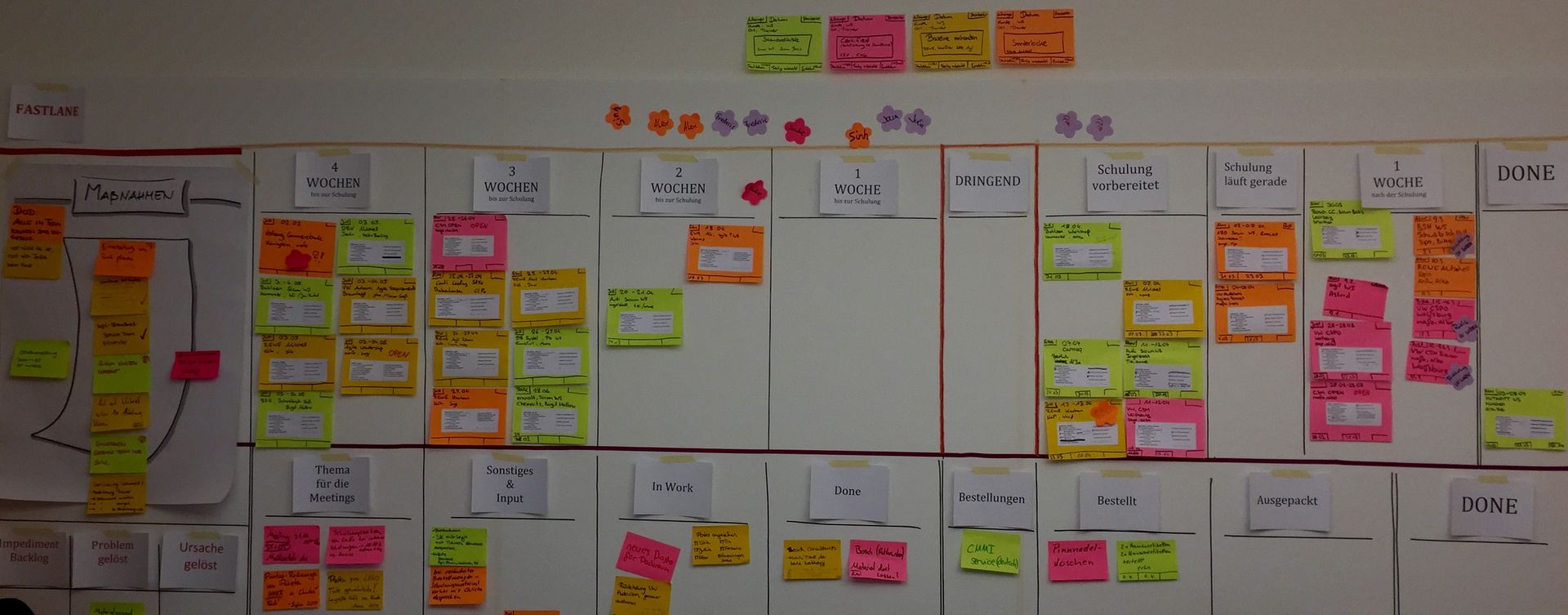Anna:
Hello dear service team,
First of all, thank you for taking the time to talk to me about your experiences as a Kanban team.
Can you briefly describe what you do exactly?
Sadie:
We work as an independent team and are responsible for organizing training courses.
Alex:
Exactly, as a service team we organize the training courses after a purchase. We are in close contact with our customers and, of course, our trainers. We gather all the information for our trainers and make sure that they have the material they need at the training location.
Anna:
Why do you use Kanban?
Alex:
In the beginning, we used Kanban as a newly assembled but self-organizing team to better understand and internalize the processes we were given. Today, we use Kanban to visualize our workflow and become more efficient. Kanban allows us to quickly recognize where bottlenecks occur and to react to spontaneous or difficult situations.
Sadie:
In our team, everyone can work on everything. It's often the case that several of us are involved in organizing a training course. That's important so that the process doesn't come to a standstill, because we're not there every day. It is therefore essential that our work is as transparent as possible. That way, we can understand what the current state of affairs is.
Anna:
How exactly does your Kanban work?
Sadie:
We use a Kanban board, which gives us transparency and helps us to see what work needs to be done.
We meet once a week for a Kaizen meeting, in which we also hold a retrospective. We look at what was good and what was bad during the week and think about how we can optimize the way we work.
Alex:
Actually, everything revolves around our Kanban board. Our board is our most important tool.
Each Kanban card on it stands for its own training course and contains the most important information as well as all the to-do's.
For example, the card shows the date of the training course, which trainer is giving it and in which city it is taking place.
Our board develops the so-called "pull" in a natural way. Our columns are divided according to the weeks preceding the training.
The first column is called "4 weeks until the training", the penultimate "1 week after the training".
This means that our cards automatically move to the right every week.
The number of cards is limited by the size of the columns. This also creates a "pull".
We have defined so-called "Do's" for each column so that we can keep an eye on which "To-Do's" should be completed on the cards in which column.
Anna:
How big is your team?
Sadie:
At the moment we are 6 people, but we are looking for one more person.
Alex:
And we have a coach.

Anna:
Is everyone always there on the same day?
Alex:
No. Because we are students on different courses, that's impossible.
We have very different study and work schedules and just want to make sure that at least one person is there every day.
Only at our weekly Kaizen meetings, where the retrospective also takes place, is everyone present.
Sadie:
There's at least one a day, we try to make it so that at least two are there, but it doesn't always work out.
Anna:
How do you manage to keep everyone informed?
Sadie:
Last semester we had a Kaizen meeting every Friday afternoon, where we were able to exchange ideas. This semester, it's a bit more critical to find a timeslot where everyone has time.
Otherwise, we try to create as much transparency as possible with our Kanban board.
Alex:
Exactly, our Kanban board provides a clear visualization of our work.
This means that everyone can see at a glance at any time what the status of a training course is and what needs to be done.
The weekly meetings are also a very important part. Before we start the retrospective, we discuss all the topics that came up during the week.
We also use e-mail, Slack and a database in which we store important information and e-mail traffic.
Otherwise, you also write your abbreviation on the Kanban card that you create. If you have any questions about the card, you immediately have a contact person.
Anna:
What were the most important things you learned?
Sadie:
To work independently in a team. To reflect and improve accordingly.
Alex:
I've learned so much in the last six months that it's hard to answer this question.
I'm just glad that we have the opportunity to learn and live all of this.
Anna:
What would you recommend to others?
Sadie:
Without our Kanban board, things would go haywire for us. This board has already established itself in other areas of my life.
Alex:
I would advise others who also use or want to use Kanban to communicate a lot and properly.
For example: the visualization of a Kanban board is great. But it gets even better if you stand in front of it, talk about it and constantly improve it.
It took us about six months to get the board out of the alpha phase and into the beta phase. But it will never actually be finished anyway.
For everyone else: give it a try. It's quick to learn, it hardly costs anything to create a Kanban board and the improvement is quickly noticeable.
Anna:
Thank you for taking the time and good luck for the future.


Write a comment